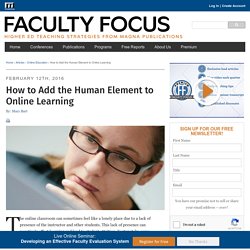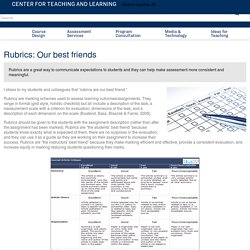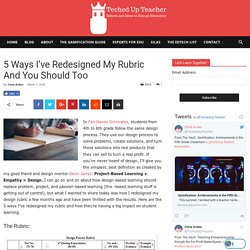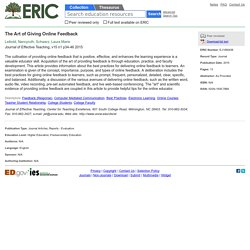

How to Add the Human Element to Online Learning. The online classroom can sometimes feel like a lonely place due to a lack of presence of the instructor and other students.

This lack of presence can negatively affect learning and lead to student attrition. Fortunately, some relatively simple measures can significantly add the essential human element to online courses. A step-by-step guide to weaving online feedback. Weaving online feedback is one of the most important things e-facilitators do.

Weaving feedback means: summarizing a discussion by finding threads of unity in the comments of participants and weaving them together into one piece of feedback to the group so that learner responses are connectedrelating learners’ contributions to existing knowledge about the topicrecognizing the contributions made by learnersprompting learners to elaborate into a direction that further supports the learning outcomes (pre-set as well as constructed). It is more than just summarizing a discussion. Instead it connects participants’ contributions to the workshop’s themes and applies higher level concepts to the participants’ ideas and experiences. Types of Rubrics: Holistic and Analytic. Meet the #SinglePointRubric. CAS Authentication wanted! Rubrics are a great way to communicate expectations to students and they can help make assessment more consistent and meaningful.

I stress to my students and colleagues that “rubrics are our best friend.” Rubrics are marking schemes used to assess learning outcomes/assignments. They range in format (grid style, holistic checklist) but all include a description of the task, a measurement scale with a criterion for evaluation, dimensions of the task, and a description of each dimension on the scale (Boatend, Bass, Blaszak & Farrar, 2009). Rubrics should be given to the students with the assignment description (rather than after the assignment has been marked). Giving Student Feedback: 20 Tips To Do It Right. It seems as if it was yesterday that I was a young middle school student giving a class presentation on the lifespan of the killer whale.

While I was prepared, I was also horribly nervous. At the conclusion of my speech I was given verbal student feedback from my teacher–in front of the entire class! 5 Ways I've Redesigned My Rubric And You Should Too. In Fair Haven Innovates, students from 4th to 8th grade follow the same design process.

They use our design process to solve problems, create solutions, and turn these solutions into real products that they can sell to turn a real profit. If you’ve never heard of design, I’ll give you the simplest, best definition as created by my good friend and design mentor Kevin Jarret: Project-Based Learning + Empathy = Design. I can go on and on about how design-based learning should replace problem, project, and passion-based learning (this -based learning stuff is getting out of control), but what I wanted to share today was how I redesigned my design rubric a few months ago and have been thrilled with the results. Here are the 5 ways I’ve redesigned my rubric and how they’re having a big impact on student learning. The Rubric: 1. Advantages and Disadvantages of Rubrics. Although rubrics have many potential benefits for both students and teachers, a poorly constructed rubric can do more harm than good.

Luckily, there are a number of predictable pitfalls that can be easily avoided if you know what to look out for. Extreme Scales Although the scale may seem like a fairly straightforward decision to make, there are many different options. One teacher might use a scale of A-F, another might use the scale 1 through 5, and yet another might choose to use the words excellent, competent, and needs work as the scale. EJ1060438 - The Art of Giving Online Feedback, Journal of Effective Teaching, 2015. The cultivation of providing online feedback that is positive, effective, and enhances the learning experience is a valuable educator skill.

Acquisition of the art of providing feedback is through education, practice, and faculty development. This article provides information about the best practices for delivering online feedback to learners. An examination is given of the concept, importance, purpose, and types of online feedback. A deliberation includes the best practices for giving online feedback to learners, such as prompt, frequent, personalized, detailed, clear, specific, and balanced. Additionally, a discussion of the various avenues of delivering online feedback, such as the written word, audio file, video recording, pre-set automated feedback, and live web-based conferencing. Journal of Effective Teaching. Five Ways to Make Peer Feedback Effective In Your Classroom.
Three years ago I was teaching a graduate computer science course with 20 students.

When students weren’t solving assignments or giving presentations, I was able to spend my time interacting with them one-on-one. The class operated smoothly. Then I changed the title of the course to include the words “big data”. Feedback in the Mathematics Classroom. Feedback in the Mathematics Classroom “Less teaching plus more feedback is the key to achieving greater learning.”

Grant Wiggins According of John Hattie, feedback is one of the most powerful influences on improved academic achievement. In fact, after his synthesis of more than 900 meta-analyses, he found that feedback had one of the highest effects on student learning. Grading as Pedagogical Act: Three Methods for Assessing Writing That Work – Texas Success Initiative PD: TX DEPCO. Lisa Hoeffner, Ph.D.

Lisa Hoeffner earned a Ph.D. in English with an emphasis in rhetoric from the University of Houston. She teaches English and Integrated Reading and Writing at McLennan Community College in Waco, Texas. She is the author of two developmental education textbooks, Common Places: Integrated Reading and Writing (McGraw-Hill, 2015) and Common Ground (McGraw-Hill, forthcoming) and speaks nationally on issues related to developmental education reform. Anyone who has taught writing knows the dread that attends grading a stack of essays. Research suggests that grading can be a pedagogical act—an act that teaches students how to improve their writing—if practitioners take care to use effective assessment methods. 1. 2. 3. Rubric Directory Cal State Fullerton. 7 Good Screen Capture Tools for Teachers. Introducing new technology tools to your students or to your colleagues can become a frustrating exercise if you end up repeating the same step-by-step directions over and over again.
Not only is it frustrating for you to repeat those directions, it can also be frustrating for the students who want to go ahead but can't because you're waiting until everyone is on the same page. One way to avoid that is to create annotated screen captures of the tools you're introducing. Another way to avoid repeating directions over and over again is to creating screencast videos in which you explain each step of the process. Recommendations for Writing Comments on Student Papers. . :VirtualSalt Robert Harris Version Date: April 29, 1997 Writing comments on student papers is something of an art: it requires a little thought and practice for the comments to be effective--that is, both read and attended to. The following recommendations about writing comments were developed for students in writing and literature classes; however, with a little adjustment, they can be applied to any writing assignment. 1. 2. 3.
Peer Review. Grades 9 – 12 | Lesson Plan | Standard Lesson. Using%20Peer%20Review%20to%20Improve%20Student%20Writing.pdf. Rubric_004.pdf. Using Tech Tools to Provide Timely Feedback. One of the most powerful moments in my teaching journey was the summer I immersed myself in feedback and checking for understanding. It forced me to ask myself what and if my students were actually learning. I learned the importance of the language I used. I also learned effective ways to track student progress toward learning goals that will inform the feedback I give students.
While my effectiveness as a teacher has grown exponentially, I still have a lot to learn. Since I teach in a lab, I also have both the challenge and the perk of most student work being completed on the computer. 1) The Comment Feature. Guide_for_academic_staff.pdf. How Rubrics Provide Feedback. I’d like to start with an assumption about rubrics.
Sample End Comments. The following sample end comments correspond to the marginal comments listed in the previous section: You've done an excellent job combining all of what we've discussed in Unit 1 into a strong ARE. Gettysburg College - How to Develop a Rubric. 1. Using Rubrics. A rubric is a type of scoring guide that assesses and articulates specific components and expectations for an assignment. RubiStar Home. Rubrics_for_assessment.pdf. ‘Speaking to Students’ with Audio Feedback in Online Courses. Using Rubrics. DIRTy Work. Excuse the cheap pun of a title. With all the public furore about the Daily Mail I couldn’t help but be mindful of a tabloid headline! DIRT, if you didn’t know, is an acronym.
Using DIRT as a Learning Journey. Education is full of acronyms. Some are useless, whilst others are impressive and useful. Commenting on Student Writing. Responding to Student Writing. Your comments on student writing should clearly reflect the hierarchy of your concerns about the paper. Major issues should be treated more prominently and at greater length; minor issues should be treated briefly or not at all. If you comment extensively on grammatical or mechanical issues, you should expect students to infer that such issues are among your main concerns with the paper.
Educational Leadership:Feedback for Learning:Good Feedback Is Targeted, Specific, Timely. Many parents have observed the irony that a child who shows little perseverance when practicing piano or doing homework will joyfully commit countless hours to mastering Guitar Hero or other video games. In fact, by the time the average U.S. adolescent turns 21, he or she will have spent 10,000 hours playing video games (Prensky, 2001)—which is, as it turns out, about the same amount of time necessary to fully master a sport, musical instrument, or area of professional expertise (Ericsson, Krampe, & Tesch-Romer, 1993).
Feedback. Index. EJ1029131.pdf. De-grade your classroom with narrative feedback SmartBlogs. Years ago, I stopped grading my students. This is shocking to most educators who wonder how assessment can be done without numbers and letters. The answer is surprisingly simple: I replace grades with narrative feedback. Renowned education professor and researcher Dylan Wiliam, who has studied feedback and grades for decades, recommends in his book “Embedded Formative Assessment” using narrative feedback in lieu of grades, rather than in addition to letters and numbers. Wiliam suggests that grades detract from the value of the feedback.
The research in favor of feedback is undeniable, and it suggests that eliminating grades can revolutionize learning. In my class, students complete many activities and projects on blogs and other web-based tools. Grading, Assessment, or Feedback? Setting Objectives and Providing Feedback. Using Technology To Provide Student Feedback. Feedback for Learning:Seven Keys to Effective Feedback. Hattie & Timperley, The Power of feedback. Getting feedback right Part 1 – Why do we give it. Marking is an act of love. Marking Matters. Feedback for Learning:Seven Keys to Effective Feedback. @Westylish's Blog: The Impact of Personalised Video Feedback on Sixth Form Hi... Authentic Assessment Toolbox Home Page. Instructor Feedback Writ Large 3. Beyond the Red Pen: Clarifying Our Role in the Response Process., English Journal, 2000.
Effective Faculty Feedback: The Road Less Traveled, Assessing Writing, 2006. The Effects of Written Comments on the Quality of Student Compositions and the Learning of Content., Reading Psychology, 1987. Bob Mayberry, Against Marking. Educational Leadership:Early Intervention at Every Age:The Perils and Promises of Praise. Carol Dweck: The power of believing that you can improve. Rubric Gallery: List of public rubrics: RCampus. 5 Tips for a More Meaningful Rubric. Using Student Feedback toImprove Teaching. Using Student Feedback. Using Student Feedback.